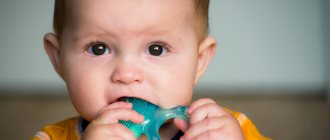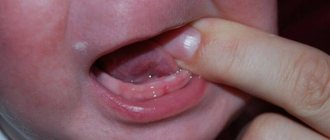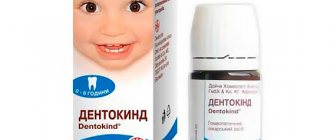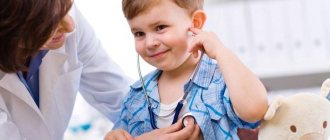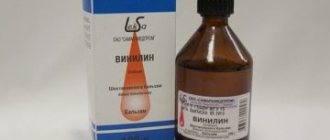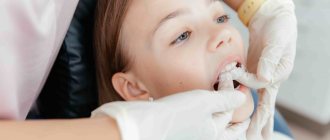Why measure temperature?
The measurement has primarily diagnostic value. We approach conditions in which the temperature is above or below the conventional limit of 38 degrees Celsius a little differently. Since most fevers in our latitudes go away on their own within 3 days, in the absence of threatening symptoms, I recommend observation for 72 hours after the first rise in temperature above 38. If after this period it rises again above 38, a doctor’s examination is necessary to decide whether whether this is a lingering virus (and we continue to observe) or whether more aggressive intervention is required. Thus, we measure temperature to determine treatment tactics, but not to resolve the issue of antipyretic treatment.
How to help a child when he is sick and what to do? Treatment methods
There is no clear treatment for colic in children, but pediatricians advise the following:
- abdominal massage after feeding;
- gymnastics (pressing your legs to your stomach);
- after feeding, you need to carry the baby upright for fifteen minutes so that he burps;
- place the baby on his stomach. Source: E.S. Keshishyan, Doctor of Medical Sciences, Professor, E.K. Berdnikova Functional intestinal colic. Tactics for their correction in young children // Medical Council, 2013, pp. 106-109
In some cases, your doctor may recommend using a special gas tube.
If the colic is severe, then a gas tube may be used.
Medical pediatricians will teach you how to properly give your baby a breast or a bottle so that he does not swallow excess air when feeding. Correcting the nutrition of a nursing mother is also important. The list of prohibited products is compiled together with the attending physician.
In some cases, doctors recommend taking medications to stabilize the child’s condition. Specific prescriptions depend on the identified causes of the child’s anxiety.
The following medications are often prescribed:
- probiotics;
- sedatives;
- medications for dysbacteriosis;
- preparations with enzymes.
What can you give a child for colic?
- Herbal carminatives.
- Enzyme preparations.
- "Espumizan" if the cause is flatulence.
- Dill decoction when colic is caused by gases.
- Herbal preparation "Plantex".
- Defoamers based on simenticon (when the cause is flatulence due to foaming in the intestines). These are “Espumizan L”, “Sab Simplex”, “Bobotik”.
- No-Spa will help relieve spasms.
- If the cause is a microflora disorder, then probiotics are given, for example Lactobacillus reuteri.
How to decide whether to lower the temperature?
The answer is simple, regardless of the cause of the temperature. It doesn’t matter whether it is associated with an infection or a post-vaccination reaction, with teething or other reasons.
We lower the temperature when the child feels unwell.
There is nothing so beneficial about a rise in temperature that you have to endure it, and nothing so harmful that you need to take medicine while feeling normal. Therefore, when deciding on the issue of fever reduction, we look not at the thermometer, but at the child. If he feels bad, he’s breathing heavily, lethargic, his muscles or head hurt - you even lower 37.8. But if you can't get a child at 38.8 to get the medicine into him, then there's no need for the medicine.
The most pressing problem in Russia is pharmacotherapy in pediatric practice. Today, medications are widely used that are either not officially approved for use in children (unlicensed), or are not used in accordance with the instructions for use of the drug (off label), or a large number of medications are used at the same time (polypharmacy), especially those that do not have proven effectiveness. in children. Unregulated prescriptions often account for about 10% when treating a child in an outpatient setting. More than a third of adverse drug side effects occurring in pediatrics are caused by unlicensed or off-label prescriptions [1].
Over-the-counter dispensing of such groups of drugs as non-steroidal anti-inflammatory drugs (NSAIDs) and antibiotics leads to an increase in side effects in children (data from a systematic review of RMD RM Smyth et al., 2012) [2].
The peculiarities of prescribing drugs in children are due to the different pharmacokinetics of drugs, ranging from the absorption of the active substance in the child’s gastrointestinal tract, the connection with proteins due to a different composition of protein fractions, and ending with the immaturity of the child’s excretory system [3].
Thus, unregulated pharmacotherapy is often accompanied by an increased risk of complications and can lead to prolongation of the underlying disease.
The problem of off-label prescriptions is most clearly presented in the treatment of acute respiratory diseases, spastic conditions, and pain syndromes, since to alleviate the suffering of a child, higher doses, different frequency of prescriptions, combinations with other NSAIDs not approved for use in children, and additional prescription of such drugs are often used. drugs such as antihistamines, myotropic, immunomodulatory, sedatives, on the one hand, capable of quickly and effectively stopping almost any symptom, on the other hand, blocking and inhibiting the physiological course of biologically expedient processes of self-regulation of the body.
For example, the use of NSAIDs leads to inhibition of the inflammatory process, which disrupts its physiological course and makes it difficult to fully complete it. Therefore, long-term use of NSAIDs during acute and subacute course of the disease can contribute to chronicity of the process, as well as the development of various complications.
Today, naturopathic treatment is becoming increasingly popular in the world. In European countries, especially Germany, homeopathic remedies have been officially prescribed by traditional practitioners for more than 80 years [4].
The drug Viburkol (Biologische Heilmittel Heel GmbH, Heel) is widely used for diseases in children by both foreign and domestic doctors [5, 6, 8–19, 20]. Viburkol belongs to antihomotoxic drugs, the action of which is based on the complementary principle and stimulation of the body’s own forces. Antihomotoxic drugs are made from natural products in minimal dosages, they are prescribed on the basis of a clinical diagnosis, the complex composition allows them to be used according to indications, making the drugs available for use by doctors who do not have special homeopathic training.
To reduce the use of high doses of NSAIDs and the prescription of several drugs with questionable effectiveness, it is possible to use low-dose complex antihomotoxic drugs in children. For example, the drug Viburkol has certain advantages: firstly, it provides a quick and pronounced effect comparable to NSAIDs; secondly, it has minimal side effects; thirdly, it has a convenient registered dosage form for children and is used from the age of one year; compatible with other complex biological and allopathic drugs, when used together with which their side effects are minimized. At the same time, Viburcol has a favorable safety and tolerability profile [5, 6, 7–16].
Currently, in Russia, the drug Viburkol is registered in the form of a pediatric form “Homeopathic rectal suppositories” (see table). It consists of six components (five plant and one mineral), which, thanks to a special stepwise homeopathic manufacturing technology, are contained in the preparation in ultra-low doses. It is thanks to its composition that Viburkol is well tolerated by children and, unlike traditional allopathic drugs, helps restore self-regulation processes in the body, activate detoxification processes and normalize impaired functions [5, 6, 7–19]. Chamomilla recutita (officinalis chamomile), which is part of the drug, increases the threshold for pain perception and restores autonomic regulation in the body. It is used for nervous excitement in children due to fever, teething, and intestinal colic. Chamomile is effective for pain in children associated with hypersensitivity and physiological immaturity of the nervous system. Belladonna (belladonna) enhances the effect of Chamomilla recutita and is a basic component for the treatment of pain in children. Dulcamara (bittersweet nightshade) provides a tranquilizing effect. Plantago major (large plantain) has a sedative effect. Pulsatilla (anemone) normalizes hormonal balance and is also one of the most effective homeopathic ingredients for pain relief. Calcium carbonicum has a pronounced analgesic effect [5–7].
Thanks to these components, Viburkol has a complex effect: analgesic, antispasmodic, sedative, anti-inflammatory. A special feature of the drug is that its use in diseases with fever is not accompanied by a sharp decrease in body temperature, the drug does not affect the metabolism of arachidonic acid. This is due to the fact that its complex action is based on the activation of the body’s defense mechanisms and contributes to a biologically expedient reduction in elevated body temperature, maintaining it at an optimal level that preserves the effective functioning of the immune system: interferon synthesis, activation of phagocytosis [6–8].
Thanks to this complex action, the indications for use of Viburkol cover a wide range of diseases and conditions in children. These are inflammatory processes with pain during teething, otitis [5], infectious diseases (acute respiratory viral infections - ARVI, influenza), acute diseases of the upper respiratory tract, childhood infectious diseases (chicken pox, measles, rubella) accompanied by fever [5, 12–15], spastic conditions (intestinal colic) [15], nervous agitation, anxiety against the background of elevated body temperature [6, 10, 15, 16, 18, 20], as well as prevention of convulsive readiness against the background of increased body temperature.
However, it must be remembered that in Russia this drug is registered only “as part of complex therapy (as an antipyretic and anti-inflammatory agent) in the treatment of respiratory diseases in children, as well as for the relief of clinical manifestations during the eruption of baby teeth” [21].
Dosage regimen recommended by the instructions: for ARVI and painful symptoms of eruption of baby teeth, children under 6 months, 1 suppository 2 times a day, children over 6 months with a body temperature above 37.5 ° C, 1 suppository 4 times a day, with a body temperature above 38°C 1 suppository up to 6 times a day. When body temperature normalizes, take 1 suppository 1–2 times a day for another 3–4 days [21].
The effectiveness and good tolerability of Viburkol for the above diseases and conditions have been studied and confirmed by a number of scientific and clinical studies since the 1980s. The results of a study of the drug Viburkol were first published in 1986. Treatment was carried out in a group of 44 children under the age of 2 years who suffered from an uncomplicated viral upper respiratory tract infection.
The study noted the effectiveness of the therapy; no side effects were observed [22].
A study of Viburkol suppositories was also conducted in 3009 children under 1 year of age who suffered from acute respiratory diseases (2173 children), restlessness due to fever (341 children), abdominal cramps (127 children), pain (291 children) and other symptoms (77 children). During treatment, the drug was prescribed in the form of suppositories 2-3 times a day to 71.3% of patients. With the therapy, recovery occurred in less than a week in 56.5% of patients. In the cohort of sick children, 82.7% of patients rated the effect as “very good” or “good.” Only 4.6% of children showed no improvement, and 0.5% experienced deterioration. Of the side effects, 9 cases of diarrhea were described, 2 patients noted pain when administering the suppository [23].
A study of Viburkol was also conducted for general anxiety against the background of fever, acute respiratory diseases and teething in 30 children. A positive effect was achieved in 25 children. No side effects were recorded [24].
German specialists B. Müller-Krampe, R. Gottwald, M. Weiser in 2002 conducted a multicenter prospective controlled cohort study in which they compared the effectiveness and tolerability of Viburkol and paracetamol in the symptomatic treatment of acute febrile conditions in children.
The study included 767 patients; the main group (361) took Viburkol, the control group (406) took paracetamol. The danger of using paracetamol is associated with the narrow range between therapeutic and toxic doses. Due to the over-the-counter status of paracetamol, there is a high risk of overdose during self-medication, which can cause severe side effects. Therefore, Viburkol was chosen for comparison as a drug that helps eliminate specific symptoms without pronounced toxic effects. The criteria for effectiveness and tolerability were body temperature, feeling sick, severity of fever, severity of clinical symptoms (spasms caused by infection and temperature, general anxiety and sleep disturbance, screaming/crying, difficulty eating/drinking, time of improvement of feverish symptoms), overall treatment outcome, side effects and overall assessment of tolerability. As a result of treatment, a marked improvement in clinical parameters was observed in both groups. The following conclusions were drawn: Viburkol is a reliable, effective and safe drug for the symptomatic treatment of diseases accompanied by fever in children. At the same time, it has a therapeutic potential comparable to paracetamol and its use does not pose the risk of developing side effects characteristic of paracetamol [15].
In 2005, Belgian clinicians led by M. Derasse compared the effectiveness and tolerability of the drug Viburcol with paracetamol in febrile conditions [16].
The study involved 208 children (under 11 years of age) from 38 medical centers in Belgium. The main group (107) of patients took Viburcol for rhinitis, otitis, bronchitis and tonsillitis [16]. It was concluded that Viburkol is well tolerated and is not inferior in effectiveness to paracetamol. Doctors and parents were more likely to rate Viburcol "excellent" (93%) than acetaminophen (80%). The study showed that for clinicians and parents concerned about the possible risks of treatment, Viburkol is an effective, well-tolerated alternative to paracetamol in the symptomatic treatment of children with acute infection accompanied by fever [16].
In conclusion, I would like to note that Viburkol is an effective registered drug that has undergone clinical trials not only in Russia, but also abroad, with a well-studied tolerability and safety profile. The use of Viburkol in addition to standard therapy for acute respiratory infections accompanied by fever, pain associated with teething or respiratory infection leads to a reduction in the risk of developing side effects as a result of taking NSAIDs, reduces the number of drugs used simultaneously, and reduces the likelihood of using off-label drugs.
How to reduce temperature?
Since this question is asked only by parents of young children, I will not write about medications for older children.
There are only three home remedies for kids to reduce their fever: the physical method, paracetamol (acetaminophen) and ibuprofen. If the child's arms and legs are warm, he needs to be undressed, you can hang him with wet towels, wipe him with water at room temperature, wrap his head in a wet scarf, or even put him in a cool shower. Whether or not to give medicine is your choice. Depends on your level of panic and your child's behavior. Small children cool down well on their own; sometimes it’s enough just to free them from their clothes. If your hands and feet are cold—vasospasm has begun—the physical method is not recommended, and the only option left is medication.
Symptoms of COVID-19 in children
Coronavirus in children is insidious in that its symptoms are often less pronounced than in adults and are more similar to ARVI. Parents think that the baby has a common cold and do not consult a doctor. And on days 5-7, the child rapidly develops complications: pneumonia, bronchitis, neuritis, myocarditis, etc. Chronic diseases can also worsen.
If in adults there is usually a certain sequence of appearance of clinical signs by day, then in pediatric patients it is not possible to identify these patterns. The development of COVID-19 in children depends on:
- type of SARS-CoV-2 strain;
- the state of the immune system of a small patient;
- source, type, duration of infection and other factors.
Symptoms of coronavirus in children at the onset of illness may resemble:
- common respiratory illness (runny nose, fever, dry cough, sore throat);
- flu (weakness, lethargy, fever);
- intestinal infection (nausea with vomiting, diarrhea, abdominal pain).
However, Covid rarely begins with loss of smell and taste. Often this symptom is not observed in children at all.
How to dose?
The easiest way to dose Nurofen is: syrup dose (ml) = 1/2 weight (kg). This is based on a single dosage of 10 mg/kg ibuprofen.
Paracetamol is dosed at 15 mg/kg. If you dose the most popular syrup - Panadol - you can multiply the child’s weight in kg by 0.625.
A single dose can be given no more than once every 4 hours, but preferably no more than 3 times a day.
You should not use the dosage according to age, which is often placed on the packaging of drugs. This is dangerous because children of the same age weigh very differently. Correctly dose medications by weight or body surface area, but not by age.
Disease prevention
Preventive measures for colic in children come down to monitoring the nutrition of the nursing mother and following other pediatrician’s instructions from the first days of life.
During the first year of a child's life, it is especially important to regularly visit a qualified pediatrician and follow all his instructions. Doctors at the pediatric medical department have the necessary qualifications and experience to treat the youngest patients. If your baby experiences anxiety, often cries and sleeps poorly, then consult a pediatrician at SM-Clinic.
Sources:
- N.I. Ursova. Infantile intestinal colic. Modern data // Issues of modern pediatrics, 2011, vol. 10, no. 2, pp. 125-131.
- I.A. Belyaeva. Intestinal colic in newborns and infants: from diagnostic issues to differentiated correction // Issues of modern pediatrics, 2011, v. 10, no. 2, pp. 137-140.
- E.S. Keshishyan, Doctor of Medical Sciences, Professor, E.K. Berdnikova. Functional intestinal colic. Tactics for their correction in young children // Medical Council, 2013, pp. 106-109.
Grek Elena Anatolyevna Clinic
Author of the article
Grek Elena Anatolyevna
Doctor of the highest qualification category
Specialty: gastroenterologist
Experience: 24 years
The information in this article is provided for reference purposes and does not replace advice from a qualified professional. Don't self-medicate! At the first signs of illness, you should consult a doctor.
When to call an ambulance?
There is no need to call an ambulance. No isolated increase in temperature is a reason for this. Isolated means that there are no other threatening symptoms, such as an unclear rash, severe shortness of breath or a bulging fontanel. Yes, an ambulance can always lower the temperature - with a lytic mixture or a hormone. But this is not necessary and may cause harm. The drug that forms the basis of the lytic mixture - analgin (metamizole) - is prohibited in children throughout the civilized world. In addition, the ambulance is more likely to offer hospitalization.
Fever is not an emergency condition. If it worries you, lower your temperature and go to the doctor. Or call a doctor at home as planned.
Source: telegram.me/fediatrix
Signs of acute colic
Usually, during an attack, the child screams shrilly and unexpectedly , and shows extreme anxiety during feeding. Until the attack ends, it is almost impossible to calm the baby down - neither motion sickness, nor changing clothes, nor regurgitation help. Source: I.A. Belyaeva Intestinal colic in newborns and infants: from diagnostic issues to differentiated correction Issues of modern pediatrics, 2011, v. 10, no. 2, pp. 137-140. Lying in bed, the child tosses and turns from side to side, clenches his fists, and may blush or turn pale. You can see a “grimace of pain” on his face. The abdominal muscles become stiff and tense, which can be felt when touched. You can see bloating in the abdomen, the child is passing gas in large quantities.
Colic as a symptom
Although in medicine it is not customary to call colic either a disease or a symptom, they do occur against the background of other diseases. That is why it is imperative to show the child to the pediatrician to rule out:
- intestinal spasm;
- intestinal obstruction;
- flatulence;
- abnormal development of the gastrointestinal tract;
- disruption of the digestion process;
- lactase deficiency;
- allergies.

